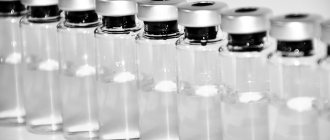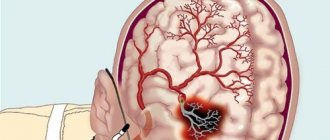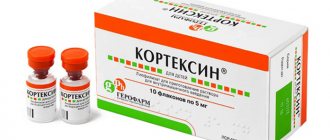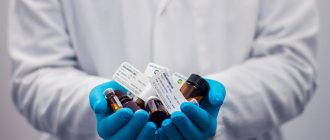Description:
Cortexin is a unique Russian development, which is based on low-molecular peptides that have the properties of transmitting information necessary for the proper functioning, interaction and development of cells, in particular brain cells.
Cortexin normalizes brain functions. The neuroprotective effectiveness of the drug Cortexin has been proven at various levels of research: clinical, biological, cellular, molecular and genetic.
The distinctive positive features of Cortexin over other neuroprotectors are:
- low dosage,
- absence of pronounced toxic effects,
- softness and duration of impact.
Cortexin has been proven to be most effective in treating the following diseases:
1. Recovery after ischemic strokes. Cortexin has a therapeutic effect starting from the first hours after ischemic brain damage.
2. Traumatic brain injury and recovery after it.
3. Delays in psychomotor and speech development in children.
Lactation and pregnancy
A contraindication to Cortexin is pregnancy; the medication is prohibited during this period of time due to the lack of clinical experience and information regarding the safety of the effect on the intrauterine development of the fetus.
If medication therapy must be carried out during breastfeeding, the woman is advised to stop it.
Pharmacological action of the drug:
Nootropic drug.
Neuroprotective effect:
In acute and chronic neuronal damage, it reduces cytotoxic cerebral edema, normalizes reparative processes in the brain and remyelination processes of the peripheral nervous system, promotes stable brain activity, protects neurons from damage by various endogenous neurotoxic factors (glutamate, calcium ions, free radicals), reduces toxic effects neurotropic substances and neuronal apoptosis.
Nootropic effect:
Preserves and enhances higher brain functions, improves learning and memory processes, concentration, general tone of the nervous system and resistance to various stress influences.
Antioxidant action
Inhibits lipid peroxidation in neurons and glial cells, ensures long-term, stable functioning of all parts of the nervous system, activates the protection of neurons under conditions of oxidative stress.
Tissue-specific action
Activates the metabolism of neurons in the central and peripheral nervous system, helps normalize the functions of the cerebral cortex.
Cortexin has no restrictions on use in various age groups, incl. in children and elderly people.
Mechanism of action
The mechanism of action of Cortexin is due to the modulation of gene expression, activation of the brain's own peptides and neurotrophic factors; normalization of the metabolism of excitatory and inhibitory amino acids, dopamine, serotonin; GABA-ergic effect, preventing the formation of free radicals; a decrease in the concentration of lipid peroxidation products, autoimmune aggression towards the structural elements of nervous tissue, the level of paroxysmal brain activity and convulsive readiness; the ability to restore normal bioelectrical activity of the brain.
What side effects can occur in pregnant women?
Pregnancy is the greatest physiological stress for a woman's body. Inside the mother's body, the development of the fetus occurs, which has a different set of antigens. Normally, when something foreign enters the internal environment of a person, the immune system makes active attempts to expel the foreign object. However, during pregnancy, the fetus must remain inside the mother's body for about 9 months. To prevent the immune system from interfering with this process, during pregnancy the amount of hormones and substances that suppress the immune system (progesterone, estrogen, cortisol, human chorionic gonadotropin, etc.) increases.
Thanks to this mechanism, allergic reactions in pregnant women occur less frequently.
There is no information about the occurrence of side effects of Cortexin when administered to pregnant women. However, due to the small number of clinical studies on the effect of Cortexin during pregnancy, this drug is contraindicated during pregnancy.
Indications for use:
- acute and chronic cerebrovascular accidents;
- traumatic brain injury and its consequences;
- encephalopathy of various origins;
- psychoorganic syndrome;
- cognitive impairment (including memory and thinking disorders);
- acute and chronic encephalitis and encephalomyelitis;
- epilepsy;
- withdrawal syndrome;
- poisoning with psychotropic substances;
- asthenic conditions;
- vegetative-vascular dystonia;
- migraine;
- decreased learning ability;
- attention disorder with hyperactivity syndrome;
- delayed psychomotor and speech development in children;
- various forms of cerebral palsy.
In ophthalmology:
- treatment of optic nerve atrophy of various origins;
- compensated primary open-angle glaucoma (as part of complex therapy);
- degenerative diseases of the retina (as part of complex therapy).
Cortexin for children
Indications for use of the drug are:
- infectious diseases of the nervous system caused by bacteria or viruses;
- conditions accompanied by circulatory disorders in the brain;
- TBI and its consequences;
- syndrome of diffuse brain damage of various origins;
- cerebral (suprasegmental) autonomic disorders.
In combination with other drugs, the drug is prescribed for the treatment of epilepsy, as well as for the treatment of acute and chronic inflammatory diseases of the brain and/or spinal cord of various etiologies.
For children, indications for the use of Cortexin are reduced learning ability, memory and thinking disorders, psychomotor and speech development delay syndrome in children (CPRD), various forms of cerebral palsy.
The instructions for use of Cortexin for children permit the use of this drug from the first days of a child’s life.
Reviews from doctors about Cortexin for children confirm the manufacturer's statements that the drug practically does not cause adverse reactions, allergies, does not have a teratogenic or carcinogenic effect and is well tolerated by patients.
Its use in neurology, neonatology and pediatrics can improve the child’s behavior and his general condition with various types of tones, normalize memory function and speech, and relieve headaches.
The adult body is characterized by some constancy; its reaction to the introduction of various substances is usually quite predictable. Some people with a predisposition to allergies may experience reactions in the form of a rash, swelling at the injection site, swelling of the face, lips, and fever.
In clinical studies, no side effects were observed when the drug was administered to adults.
The child’s body is immature in many respects, including the state of the immune system. The development of the following allergic reactions is typical for children:
- Atopic dermatitis (the skin turns red, becomes moist, and cracks may appear);
- Allergic conjunctivitis (inflammation of the mucous membrane of the eyes) and allergic rhinitis (runny nose);
- Food allergies (nausea, vomiting, bloating, belching, bowel problems such as constipation or diarrhea);
Allergic reactions develop faster in children than in adults. The severity of these reactions varies - from minor peeling of the skin to generalized swelling of the entire body. Often, the risk of side effects depends on the child’s pre-existing condition and the presence or absence of diseases.
When Cortexin was administered to children, no adverse reactions were observed.
Application and dosage:
The drug is administered intramuscularly.
Before injection, the contents of the bottle are dissolved in 1-2 ml of 0.5% solution of procaine (novocaine), water for injection or 0.9% sodium chloride solution, directing the needle to the wall of the bottle to avoid foaming, and injected once daily:
adults at a dose of 10 mg for 10 days;
children with body weight up to 20 kg at a dose of 0.5 mg/kg,
with a body weight of more than 20 kg - at a dose of 10 mg for 10 days.
If necessary, repeat the course after 3–6 months.
For hemispheric ischemic stroke in the acute and early recovery periods, adults at a dose of 10 mg 2 times a day (morning and afternoon) for 10 days, with a repeat course after 10 days.
Release form
Pharmacies sell glass bottles with a lyophilized mass called “Cortexin” (weight - 5 or 10 mg), the active substance is represented by polypeptides that previously saturated the gray matter of the brain of calves and piglets under one year of age.
Delivery form: cardboard boxes. The package can hold two, five or ten vessels. The broad-acting drug Cortexin for adults is more often found in a 10-milligram dosage. The dose of the children's composition, consisting of a lyophilized protein fraction of brain matter obtained from cows and pigs, is half as much. Before use, the powdery mass is dissolved in injection water or anesthetic.
Glycine in the medicine acts as a stabilizer, its amount is either 6 or 12 milligrams, depending on the dose of the main substance. Cortexin is not available in tablets; the drug is manufactured strictly for intramuscular injections.
Cortexin is most widely used in Russia and neighboring countries. The manufacturer of the drug is the domestic pharmaceutical company.
The composition of the lyophilized powder contained in one bottle for the preparation of an injection solution includes 5 or 10 mg of a complex of water-soluble polypeptide fractions (cortexin) as an active substance and 6 or 12 mg of glycine as a stabilizer.
The drug is available in the form of a sterile lyophilized powder for the preparation of a solution for intramuscular administration.
The cardboard packaging is completed with two blister packs, each containing 5 bottles of lyophilisate, and instructions for use.
In pharmacies you can buy Cortexin 10 mg No. 10 and Cortexin 5 mg No. 10.
Cortexin 10 mg is available in 22 mg doses in 5 ml bottles. The product is intended for the treatment of adult patients.
Cortexin 5 mg was created specifically for use in pediatrics. It is available in 11 g bottles with a capacity of 3 ml.
How to properly dilute lyophilisate
Before use, the powder mixture in the bottle will need to be dissolved with prepared water, novocaine solution or 0.9% saline solution to the required volume. It must be remembered that the needle must be directed directly to the wall of the bottle, thus preventing the formation of small bubbles in the injection solution.
The medicine is administered once a day. Cortexin is administered to adults at a dosage of 10 mg over the next 10 days.
If necessary, repeat the treatment course after 3-6 months. When diagnosing hemispheric ischemic stroke, inject the medicine at a dose of 10 mg. It is worth noting that the course of application is 10 days, then a repeat course is indicated after 10 days.
How to inject a child with Cortexin?
Cortexin can be prescribed from the first days of life. In some situations, parents have to give their child injections themselves. And here questions arise: how to properly inject Cortexin and what is the best way to dilute the powder.
- Before making an injection, water for injection, novocaine or saline solution is drawn into the syringe, then the cap of the bottle is pierced and the collected liquid is poured into it.
- The syringe should be removed (the needle remains in the cap) and the contents of the bottle should be thoroughly shaken until the powder is completely dissolved. After this, the syringe is reattached and the required amount of solution is drawn into it.
- For an injection, it is better to take a new needle, since the needle with which the solvent for the lyophilisate was injected may already be fairly dull.
- The medicine is administered slowly, as rapid administration can cause very severe pain.
For babies up to six months old, an intramuscular injection is given into the anterior surface of the thigh (so as not to accidentally damage the sciatic nerve).
For children, all injections are given with saline or water for injection. Injections with novocaine are less painful than injections with saline solution, however, diluting the drug with novocaine is allowed only if there is firm confidence that this will not cause an allergic reaction in the child (novocaine can cause severe allergies and convulsions).
Read also: Why is Phenazepam prescribed? Instructions, reviews and analogues, price in pharmacies
Like other neurometabolic drugs, Cortexin is recommended to be injected before 12 noon, given its activating effect and ability to provoke psychomotor agitation.
Comparison of Cortexin and Actovegin
There are both similar and distinctive characteristics between the drugs.
Compound similarities
Similar features of nootropic medications:
- The active ingredients are substances of animal origin, which reduce the risk of side effects.
- Prescribed to improve cerebral circulation, for encephalopathy, angiopathy and traumatic brain injury.
- Can be used together in the absence of allergic reactions or individual intolerance to certain components.
- They do not interact with other medications, so they can be prescribed in complex treatment.
What is the difference?
Differences between drugs:
- They have different effects on the body. The action of Actovegin is aimed at stimulating enzyme activity and eliminating antihypoxic conditions. Cortexin is aimed at normalizing metabolic processes in brain cells. Participates in improving cellular protein synthesis.
- Actovegin does not have a negative effect on the development of pregnancy and the fetus. Cortexin should not be taken by nursing or pregnant women.
- Release forms.
- Actovegin shows excellent results during the treatment of vegetative-vascular dystonia, and Cortexin is considered the only drug that can cope with congenital injuries of the central nervous system in newborns.
Price
The cost of Cortexin in powder form for injection varies from 900 to 1600 rubles. Actovegin solution costs from 600 to 1200 rubles, and tablets average about 1500.
Conditions for dispensing from pharmacies
Actovegin can be purchased only with a prescription from your doctor. Cortexin refers to medications that are included in the list of prescription drugs.
What is better Cortexin or Actovegin?
It is difficult to answer the question of which nootropic drug is better and more effective. The decision to choose a particular drug should be made by a specialist, taking into account the diagnosis, the individual characteristics of the body, the presence of contraindications in the patient and a tendency to allergies.
Both drugs are highly effective in therapeutic therapy; depending on the diagnosis, they can be prescribed either separately or injected simultaneously. Their compatibility gives a positive result in the fight against numerous diseases.
When choosing medications, the age of the patient must also be taken into account. For adults with chronic neurological conditions, Cortexin is prescribed, and for post-traumatic and acute circulatory disorders, Actovegin is recommended for use.
When treating neurological conditions, only Cortexin can be prescribed to a child, because Actovegin is contraindicated in childhood.
Mechanism of action
After injection of the drug “Cortexin”, low-molecular-weight protein molecules pass through the blood-brain barriers and have the following effects on the brain:
- Stimulation of nerve cells, due to which the balance of inhibitory and excitatory mediators is normalized.
- Protecting neurons from all kinds of damaging factors, for example, from hypoxia, exposure to calcium ions and free radicals. This therapeutic effect is called cerebro- or neuroprotective. This develops the resistance of nerve cells to negative external influences, including stress and the use of certain psychotropic medications.
- Activation of metabolic processes in brain tissue and acceleration of the recovery of nerve cells, as a result of which the functions of the central nervous system and its overall tone are improved.
- Highly effective when influencing those areas of the brain that are responsible for the ability to work and learn new material. This effect is called nootropic and consists of improving thinking, attention and memory.
- Reducing seizure activity in cases of brain dysfunction. As a result, the use of the drug Cortexin helps prevent the occurrence of seizures.
- Slowing down oxidative processes in brain cells, that is, the drug acts as an antioxidant.
Reviews about Cortexin for children are mostly positive.
Mode of application
The drug "Cortexin" is administered intramuscularly. Before giving the injection, the lyophilisate should be diluted, and this is done immediately before administration. For such purposes, special water for injection is used, as well as sterile saline solutions.
The medicine can also be diluted with 0.5% novocaine, but this solvent is used much less frequently. Despite the fact that it reduces pain, when diluted with an anesthetic, the effect of Cortexin decreases, and the risk of allergic reactions increases. For this reason, the use of novocaine is recommended only in cases where the child does not tolerate the injections well or they are too painful for him. At the same time, he should not have an allergy to novocaine. This is confirmed by the instructions for use of Cortexin injections for children. There are reviews on this matter.
To dilute the medicinal powder, you need to draw up the solvent in a volume of 1-2 ml using a sterile syringe, remove the foil from the lyophilisate bottle and pierce the stopper. After this, the solvent is carefully released inside so that no foam forms. In this case, the stream of liquid must be directed towards the wall of the bottle so that the liquid slowly flows onto the powder.
After this, removing the needle, you need to shake the bottle slightly until the medicinal powder is completely dissolved. When the liquid becomes clear and homogeneous, it is drawn into the same syringe and administered intramuscularly.
It should be remembered that for one injection you need to dilute the entire lyophilisate, and only after that take the required volume of the medicinal solution. Dividing the powder into parts and diluting one of them is unacceptable.
"Cortexin" is recommended to be injected into the muscles of the thigh or shoulder. To reduce pain, the injection should be performed with a thin needle and the medicine should be administered slowly. The next injection is made from the previous one at a distance of at least 1 cm.
According to reviews, Cortexin is usually well tolerated by children under one year of age.












